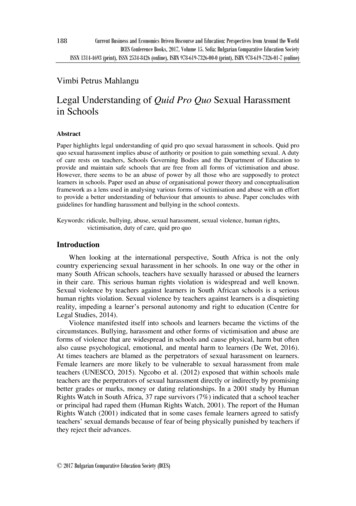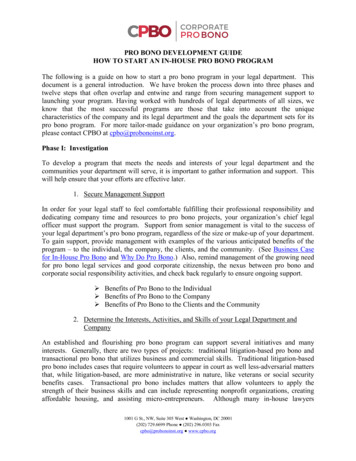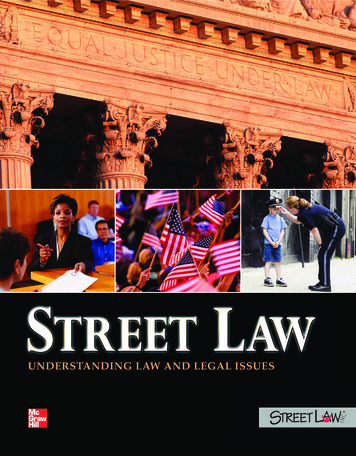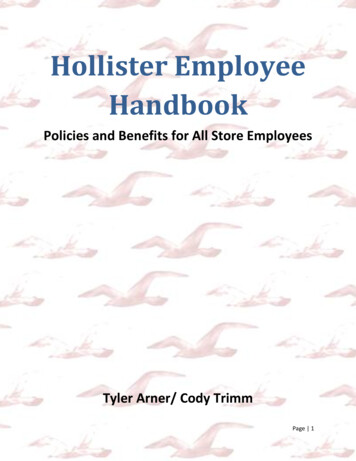
Transcription
188Current Business and Economics Driven Discourse and Education: Perspectives from Around the WorldBCES Conference Books, 2017, Volume 15. Sofia: Bulgarian Comparative Education SocietyISSN 1314-4693 (print), ISSN 2534-8426 (online), ISBN 978-619-7326-00-0 (print), ISBN 978-619-7326-01-7 (online)Vimbi Petrus MahlanguLegal Understanding of Quid Pro Quo Sexual Harassmentin SchoolsAbstractPaper highlights legal understanding of quid pro quo sexual harassment in schools. Quid proquo sexual harassment implies abuse of authority or position to gain something sexual. A dutyof care rests on teachers, Schools Governing Bodies and the Department of Education toprovide and maintain safe schools that are free from all forms of victimisation and abuse.However, there seems to be an abuse of power by all those who are supposedly to protectlearners in schools. Paper used an abuse of organisational power theory and conceptualisationframework as a lens used in analysing various forms of victimisation and abuse with an effortto provide a better understanding of behaviour that amounts to abuse. Paper concludes withguidelines for handling harassment and bullying in the school contexts.Keywords: ridicule, bullying, abuse, sexual harassment, sexual violence, human rights,victimisation, duty of care, quid pro quoIntroductionWhen looking at the international perspective, South Africa is not the onlycountry experiencing sexual harassment in her schools. In one way or the other inmany South African schools, teachers have sexually harassed or abused the learnersin their care. This serious human rights violation is widespread and well known.Sexual violence by teachers against learners in South African schools is a serioushuman rights violation. Sexual violence by teachers against learners is a disquietingreality, impeding a learner’s personal autonomy and right to education (Centre forLegal Studies, 2014).Violence manifested itself into schools and learners became the victims of thecircumstances. Bullying, harassment and other forms of victimisation and abuse areforms of violence that are widespread in schools and cause physical, harm but oftenalso cause psychological, emotional, and mental harm to learners (De Wet, 2016).At times teachers are blamed as the perpetrators of sexual harassment on learners.Female learners are more likely to be vulnerable to sexual harassment from maleteachers (UNESCO, 2015). Ngcobo et al. (2012) exposed that within schools maleteachers are the perpetrators of sexual harassment directly or indirectly by promisingbetter grades or marks, money or dating relationships. In a 2001 study by HumanRights Watch in South Africa, 37 rape survivors (7%) indicated that a school teacheror principal had raped them (Human Rights Watch, 2001). The report of the HumanRights Watch (2001) indicated that in some cases female learners agreed to satisfyteachers’ sexual demands because of fear of being physically punished by teachers ifthey reject their advances. 2017 Bulgarian Comparative Education Society (BCES)
Vimbi Petrus Mahlangu189According to Timmerman (2003) in countries like the United States of America,Netherland, Morocco and Surinam teachers are the perpetrators of sexual abuses byabusing their powers. Based on these international experiences South Africangovernment through her School Governing Bodies tried to ensure that school safetyis guaranteed in schools by developing policies. If not properly governed schoolsmay adopt unlawful school policies discriminating against learners in schools. Forexample, School Governing Bodies of two public high schools in the Free StateProvince (Harmony High School and Welkom High School) adopted pregnancypolicies that required the exclusion of pregnant learners from attending the schoolsfor a specific time (Prinsloo, 2016).MethodA qualitative approach was employed in trying to understand the concept ofquid pro quo sexual harassment in schools. Information was collected by means of aliterature review and desk-top research.Problem statementThere appeared to be an abuse of power by teachers on learners as a result ofquid pro quo. Quid pro quo sexual harassment implies abuse of authority orposition to gain something sexually (De Wet & Oosthuizen, 2010). It occurs whenthe victims felt that they had something to lose if they do not submit to sexualconduct. Effective teaching and learning is gradually undermined by a culture ofschool-based harassment and violence and this is an issue of national concern(Ncontsa & Shumba, 2013). For example, a 17 year old grade 11 learner of XXXSecondary School in KwaZulu, Natal Province, was seen in a video in different sexpositions with the 45 year old teacher and the learner appeared to be pregnant on thefootage. The young girl had admitted that she was in romantic relationship with theteacher.Theoretical argumentPaper relied on the theory of abuse of organisational power as a lens inunderstanding victimisation and abuse in schools. Within organisations people havedifferent levels of access to power positions (Timmerman, 2003). In schoolsprincipals have power over teachers and teachers have power over learners. Basedon this hierarchical authority some teachers are tempted to propose love to learners.Kheswa (2014) is of the view that female students who date older men or “sugardaddies” stay in those relationships because they are characterised by money to payfor their fees and alleviate poverty and contribute to their social status.Literature reviewSexual harassmentIt is an unwelcome hostile or intimidating behaviour in particular speech orbehaviour that is sexually aggressive or intimidating based on attributes such asrace, gender, religion, age, colour, national origin, ancestry, disability, sexualBCES Conference Books, 2017, Volume 15 / Part 5: Law and Education
190Legal Understanding of Quid Pro Quo Sexual Harassment in Schoolsorientation, or gender identity (Resnick & Farrel, 2016). Sexual harassment can beexplained as harassment that is sexual in nature, including unwelcome sexualattention and behaviour, sexual coercion or sexual bribery (De Wet, 2016).Sexual violenceIt is any sexual act or attempted sexual act using intimidation, threats orphysical force. In schools this could include sexual harassment, assault, forced sexor rape, sexual abuse and sexualised touching of another’s intimate parts or forcingany person to touch any person’s intimate parts (Coetzee, 2012). Intimate partsinclude the mouth, primary genital area, groin, inner thighs, buttocks, breasts, aswell as clothing covering these areas. Prinsloo (2006) found that many girlsexperienced violence in schools. They were raped, sexually abused, sexuallyharassed and assaulted by male learners and teachers. They were harassed by thepossibility of unwanted pregnancies and emotional pressure, and were denied oftheir self-respect. Mason-Jones, De Koker, Eggers et al. (2016) view sexual violenceas any behaviour within an intimate relationship that causes physical, psychologicalor sexual harm to those in the relationship. It can include humiliation, intimidation,physical and sexual violence such as slapping, beating, forced sex or other forms ofcoercion, and can result in severe injury and death. Chikwiri and Lemmer (2014)view sexual violence as violence or abuse by an adult or another child through anyform of forced or unwanted sexual activity where there was no consent and is oftenassociated with physical or psychological violence.Safe schoolsSafe schools are schools that are physically and psychologically safe and allowteachers, learners and non-teachers to work without fearing for their lives (Masitsa,2011). A safe school is therefore seen as a place where teachers teach and learnerslearn, and non-teachers work in a warm and welcoming environment, free ofintimidation and the fear of violence, ridicule, harassment and humiliation.According to Kheswa (2014) another form of sexual harassment is quid pro quoharassment. Quid pro quo harassment usually takes place when a female learner isforced into having sex with her teacher(s) under the threat of failing a subject.Prinsloo (2006) asserted that quid pro quo harassment occur where an owner,employer, supervisor, member of management or co-employee undertakes orattempts to influence or influences the process of employment, promotion, training,discipline, dismissal, salary increments or other benefits of an employee or jobapplicant in exchange for sexual favours. According to De Wet and Oosthuizen(2010) quid pro quo sexual harassment implied abuse of authority or position to gainsomething sexual. It occurs when the victim feels that s/he has something to lose ifs/he does not submit to sexual conduct. It is alleged in studies that in some schoolsteachers give female learners whom they abuse sexually high marks, moneyparticularly during school trips.According to De Wet (2016) Gender-based harassment (as defined by theEquality Act, SA, 2000, Section 1) referred to unwelcome behaviour that is relatedto sex, gender, sexual orientation, pregnancy, virginity or marital status. Genderbased harassment encompasses generalised sexist statements and behaviours thatconvey insulting, degrading and/or sexist attitudes that undermine the status andCurrent Business and Economics Driven Discourse and Education: Perspectives from Around the World
Vimbi Petrus Mahlangu191integrity of girls and women, or unreasonably deprive girls and women ofopportunities afforded to boys and men. Sexually coercive men tend to view genderinteractions as based on rules and scripts that are somewhat exploitative andsometimes ignored. In this regard, males could use force or aggression to get sexthat might lead to rape (Kheswa, 2014). According to Ngcobo et al. (2012) sexualharassment was seen as ‘normal’ and difficult to challenge. Thus they chose not toact. This could also mean that females have internalised violence and accept it asnormal. This is the reason why many cases of sexual assaults are not reported inschools.A hostile sexual harassment may also create a hostile atmosphere in a schoolwhere learners’ academic performance might be affected (De Wet & Oosthuizen,2010). Sexual harassment in schools can also create a hostile, intimidating oroffensive environment for the victims. Teachers by virtue of their profession and bylaw are obliged to maintain discipline in schools and to act in loco parentis inrelation to the female learners (Masitsa, 2011). Teachers as trained professionalsought to refrain from harassing and intimidating learners. They are expected to careand maintained the safety of learners under their supervision and care. In Zimbabwefemale students’ poverty provides ideal pre-conditions for sexual bartering (Masitsa,2011).Different forms of harassmentHarassment is often power-based. De Wet (2016) came up with the followingforms of abuse, namely: verbal; physical; nonverbal; emotional; relational;secondary; discriminatory; child abuse; and a hostile or unwelcoming environmentabuses. Abuse and victimisation in schools can manifest itself in various forms. Herea brief explanation will be provided of the abuses that can be found in schools.Verbal bullying or harassment involves hurtful words and includes hurtful namecalling, persistent teasing, ridicule, taunts, gossip, threatening, vulgar language,remarks or jokes of a racist, homophobic, islamaphobic, religiophobic, sexist orxenophobic nature, teasing someone about their disability, name-calling, sexualjokes, unwanted conversations of a sexual nature, whistling, crude comments (forexample about body parts), spreading slanderous rumours about someone, hatespeech and asking for or pressurising for sex.The effects of sexual harassment and bullying on learnersThe victims may suffer pain such as body injuries. De Wet (2013) is of theopinion that pain and suffering as injury to bodily integrity occur when sexualharassment results in physical injury and always in the case of sexual violence.Neetling et al. (2006) is also of the opinion that pain encompasses past and futurephysical and emotional pain. It has been found that the persistent and threateningnature of abusers’ behaviours often cause deterioration in victims’ quality of life.These behaviours can cause considerable mental health problems such asdepression, anxiety, suicidal ideation, post-traumatic stress disorder and feelings offear, terror, helplessness, distress, anger and distrust that often last many years afterabusers had ostensibly disappeared (Korkodeilou, 2016). Adolescents seem to havehigher risk of developing Post Traumatic Stress Disorders (PTSD) after violencevictimisation compared with adults. Moreover, youth suffering from different typesBCES Conference Books, 2017, Volume 15 / Part 5: Law and Education
192Legal Understanding of Quid Pro Quo Sexual Harassment in Schoolsof victimisation report more mental ill-health than youth suffering from repeatedvictimisations of the same type (Palm, Danielsson, Skalkidou, Olofsson & Högberg,2016).Psychological consequences of sexual harassment or violence are often moreserious than the physical injuries (Field, Jeffries, Zoe & Lynch, 2016).In contemporary China, both socio-cultural norms and current legislationencourage women to not to report marital rape; instead it should be viewed as afamily’s private matter that needs to be confined within the four walls of the home(Chi, 2016). This creates a vicious cycle of sexual abuse for the victims of rape inChina. Teachers are expected to be able to protect learners from the harms ofwitnessing violence perpetrated against them as evidenced through Weisz andWiersma’s (2011) U.S. study showing a broad consensus that mothers should beheld accountable for not protecting their children from witnessing their abuse evenwhen they cannot stop their partners from abusing them (Morgan & Coombes,2016).Handling of sexual harassment in schoolsSchools should have mechanism in place for handling the specific cases ofsexual harassment. When the victim is a child, the cases should be referred to thestatutory legal system and not be handled through the customary courts. In caseswhere a tangible proof can be submitted against offending teachers and principalsthe Department of Education with the authorities should take more concrete action,for example through immediate dismal of the offender (Devon, Sayndee & Bøås,2016). Establishment of a comprehensive communications strategy to educate theschool community about sexual violence and sexual assault, as well as toraise awareness about school programs; Mandatory training programs to educate learners, teachers, and district officepersonnel about prevention and response to sexual violence; Establishment of services for individuals accused of sexual violence(Napolitano, 2014); “Ensure that learners are always alerted to the legislation and policiesgoverning sexual violence in schools by teachers; Create a safe space where teachers can report colleagues without fear of theirown reputations being damaged; Impose strict internal disciplinary measures for teachers who are perpetratorsof sexual violence; Share the outcome of the disciplinary measures with teacher unions” (Centrefor Legal Studies, 2014, p. 48).ConclusionSchools should educate all learners about all behaviours that constitute sexualviolence, bullying and harassment. This would assist them to have the legalunderstanding of victimisation and abuse in schools. Teachers should act ‘in locoparentis’ (act in the place of a parent) in assisting learners in identifying all forms ofvictimisation and abuse in schools.Current Business and Economics Driven Discourse and Education: Perspectives from Around the World
Vimbi Petrus Mahlangu193Teachers should understand their duty of care and to ensure that learners havethe legal understanding and abuse that might occur to them while in schools.ReferencesCentre for Legal Studies (2014): Sexual Violence by Teachers in South African Schools: Gapsin Accountability. University of the Witwatersrand School of Law, Cornell Law School’sAvon Global Center for Women and Justice and International Human Rights Clinic.Chi, W. (2016): Not all victims of rape will be recognised as such in the eyes of the law.International Journal for Intersectional Feminist Studies, 2(1), 56-61.Chikwiri, E. & Lemmer, E. M. (2014): Gender based Violence in Primary Schools in Harareand Marondera District in Zimbabwe. Journal of Sociology and Social Anthropology,5(1), 95-105.Coetzee, S. (2012): Law and policy regulating the management of learner-on-learner sexualmisconduct in South African public schools. Child Abuse Research: A South AfricanJournal, 13(1), 27-39.De Wet, A. & Oosthuizen, I. J. (2010): The nature of learner sexual harassment in schools:An education law perspective. Acta Academica, 42(3), 194-229.De Wet, A. (2013): Father to sue education department over rape – civil remedies for sexualviolence and harassment in public schools. Child Abuse Research: A South AfricanJournal, 14(1), 22-35.De Wet, A. (2016): Understanding harassment bullying of learners in schools: Child AbuseResearch: A South African Journal, 17(1), 24-35.Devon, S. A., Sayndee, T. D. & Bøås, M. (2016): Gender Based Violence and Access toJustice: the case of Ganta, Liberia. NUPI Working Paper 864, Norwegian Institute ofInternational Affairs.Field, R., Jeffries, S., Zoe, R. A. M. & Lynch, A. (2016): Family reports and family violencein Australian family law proceedings: What do we know? 25 JJA 212, 212-236.Human Rights Watch (2001): Scared at school: Sexual violence against girls in South Africanschools. In Joubert, R. (Ed) (2015): The Law of Education. 3rd Edition. Pretoria: VanSchaik.Kheswa, J. C. (2014): Exploring the Causal Factors and the Effects Sexual Harassment onFemale Students and Universities in Africa. An overview. Mediterranean Journal ofSocial Sciences, 5(20), 2847-2852.Korkodeilou, J. (2016): ‘No place to hide’: Stalking victimisation and its psychosocial effects.International Review of Victimology, 23(1), 17-32.Masitsa, M. G. (2011): Exploring safety in township secondary schools in the Free StateProvince. South African Journal of Education, 31(2), 163-174.Mason-Jones, A. J., De Koker, P., Eggers, S. M., Mathews, C., Temmerman, M., Leye, E., deVries, P. J. & de Vries, H. (2016): Intimate partner violence in early adolescence: the roleof gender, socio-economic factors and the school. South African Medical Journal,106(5), 502-509.Morgan, M. & Coombes, L. (2016): Protective mothers: Women’s understandings ofprotecting children in the context of legal interventions into intimate partner violence.The Australian Community Psychologist, 28(1), 59-78.Napolitano, J. (2014): Only Yes Means Yes: An Essay on University Policies regardingSexual Violence and Sexual Assault. Yale Law and Policy Review, 33(2), Article 4.BCES Conference Books, 2017, Volume 15 / Part 5: Law and Education
194Legal Understanding of Quid Pro Quo Sexual Harassment in SchoolsNcontsa, V. N. & Shumba, A. (2013): The nature and the effects of school violence in SouthAfrican high schools. South African Journal of Education, 33(3), 1-15.Neethling, J., Potgieter, J. M. & Visser, P. J. (2006): Law of delict. 5th Edition. Durban:LexisNexis.Ngcobo, J. E., Ngakane, M. V. & Mutukhrishna, N. (2012): Experiencing violence in schools:Voices of learners in Lesotho Context. Anthropologist, 14(1), 39-48.Palm, A., Danielsson, I., Skalkidou, A., Olofsson, N. & Högberg, U. I. F. (2016): Violencevictimisation – a watershed for young women’s mental and physical health. TheEuropean Journal of Public Health Advance Access, 7 January, 1-6.Prinsloo, S. (2006): Sexual harassment and violence in South African schools. South AfricanJournal of Education, 26(2), 305-318.Resnick, P. & Farrel, A. (2016): IETF Anti-Harassment Procedures. Juniper Networks. March2016.Timmerman, G. (2003): Sexual Harassment of Adolescents Perpetrated by Teachers and byPeers: An Exploration of the Dynamics of Power, Culture, and Gender in SecondarySchools. Sex roles, 48(5), 231-244.UNESCO (2015): School-related gender-based violence is preventing the achievement ofquality education for all. Policy Paper 17. The paper was jointly released by theEducation for All Global Monitoring Report (GMR), UNESCO and the United NationsGirls’ Education Initiative (UNGEI) at the 59th session of the Commission on the Statusof Women in New York City (March 2015).Sources read in compiling paperDepartment of Education (2008): Guidelines for the prevention and management of sexualviolence and harassment in public schools. Pretoria: Department of Education.Republic of South Africa (2005): Children's Act 38 of 2005. Pretoria: Government Printer.Republic of South Africa (2010): Case No.: 5714/2010 and 5715/2010. Welkom High Schooland Harmony High School, the Governing Bodies of Welkom High School and HarmonyHigh School vs The Head of Department, Department of Education, Free State Province.Free State High Court, Bloemfontein, Republic of South Africa Case.Republic South Africa (2000): The Promotion of Equality and Prevention of UnfairDiscrimination Act, No 4 of 2000. Pretoria: Government Printers.Republic South Africa (2011): Protection from Harassment Act 17 of 2011. Pretoria:Government Printer.South Africa (Republic) (1996): South Africa Schools Act No 84 of 1996. Pretoria:Government Printers.South Africa (Republic) (1996): The Constitution of the Republic of South Africa, No. 108 of1996. Pretoria: Government Printer.South Africa (Republic) (2005): Amendments to the Code of Good Practice on the handlingof sexual harassment in the workplace. Pretoria: Government Printers.South African Human Rights Commission (2008): Report on the public hearing on schoolbased violence. Pretoria: Government Printers.Prof. Dr. Vimbi P. Mahlangu, University of South Africa (UNISA), South Africa,mahlavp@unisa.ac.zaCurrent Business and Economics Driven Discourse and Education: Perspectives from Around the World
learn, and non-teachers work in a warm and welcoming environment, free of intimidation and the fear of violence, ridicule, harassment and humiliation. . (2010) quid pro quo sexual harassment implied abuse of authority or position to gain something sexual. It occurs when the victim feels that s/he has something to lose if s/he does not submit .










